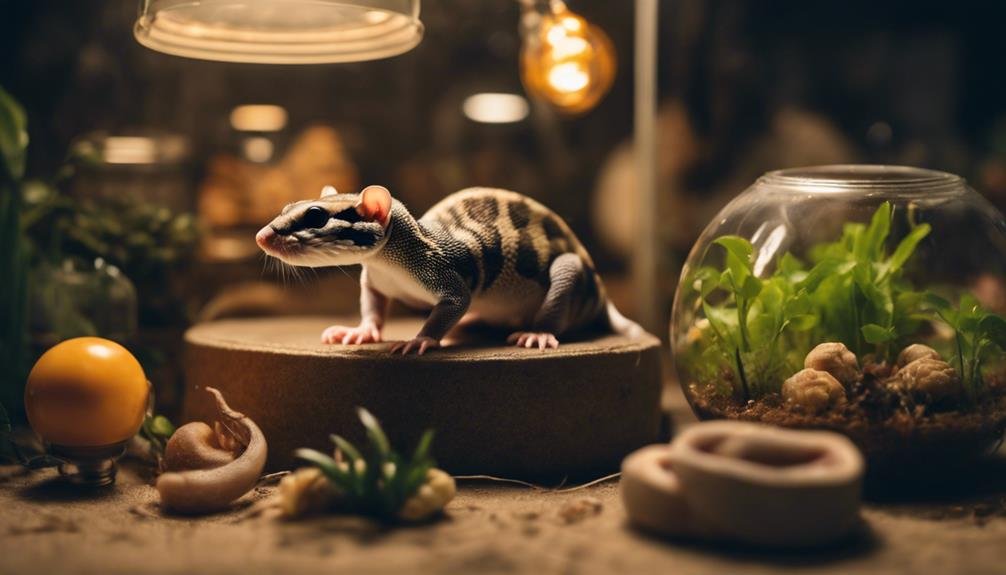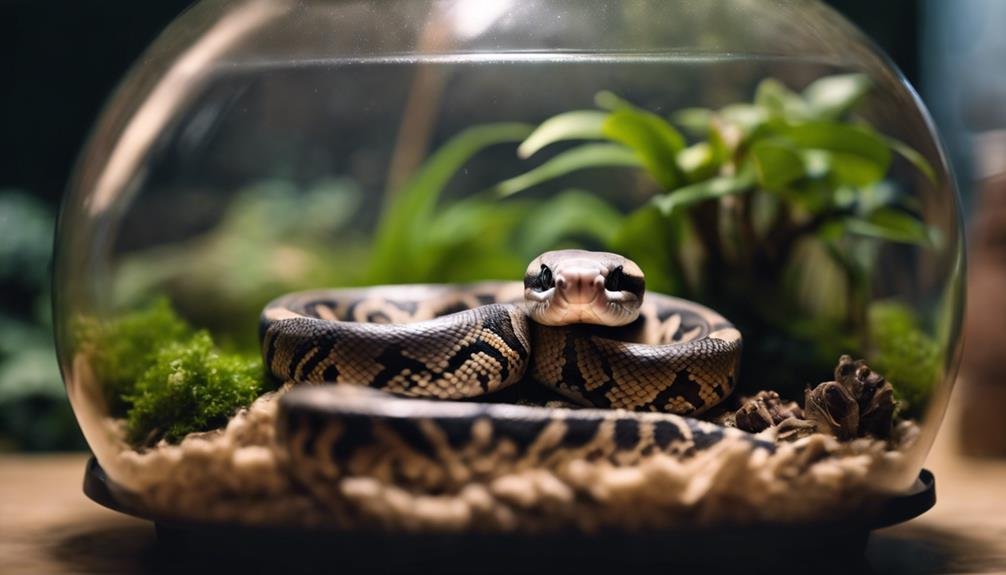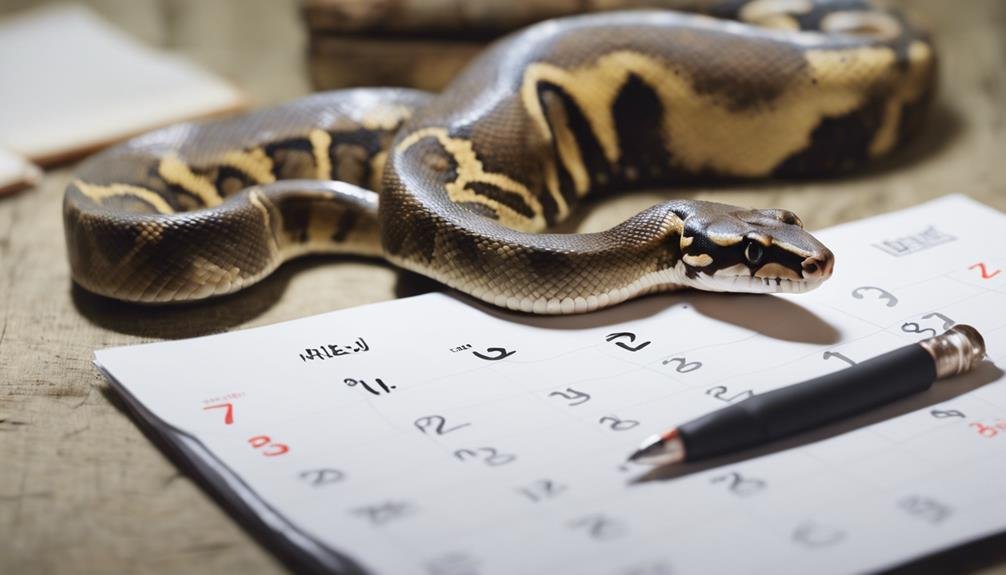Have you ever wondered how long your ball python can go without eating? It’s quite fascinating that these creatures can fast for up to six months or more, depending on various factors like their brumation cycle, stress levels, and overall health. Understanding why your ball python might refuse food is important in ensuring their well-being and addressing any potential issues early on. From recognizing the signs of stress to monitoring their health during these fasting periods, there’s a lot to think about. Let’s explore the reasons behind their fasting behavior and how you can support them through it, leaving you with a few intriguing thoughts to ponder.
Key Takeaways
- Ball pythons can survive without food for at least six months, with some fasting for up to 21 months.
- Fasting behavior can be influenced by the brumation cycle, reducing appetite due to lower metabolic rates.
- Stress from environmental changes or inadequate habitat conditions may cause ball pythons to refuse food.
- A lack of appetite over extended periods can indicate underlying health issues that need attention.
- Encouraging natural feeding behavior involves optimizing the habitat and offering a variety of prey to stimulate appetite.
Feeding Frequency Guidelines
To maintain your ball python’s health, it’s crucial to comprehend the best feeding frequency, which varies based on age and health. Juvenile ball pythons require more frequent meals, every 1-2 weeks, to support their rapid growth and development. As they mature, the feeding frequency lessens, with adult ball pythons needing to eat only every 4-6 weeks.
Monitoring your python’s weight regularly is a vital part of evaluating their feeding habits and overall health. If you notice your snake is losing weight, it’s an indication that you may need to adjust their feeding frequency or seek veterinary attention to rule out any underlying health issues.
Keep in mind, factors such as shedding, illness, and stress can greatly impact a ball python’s feeding patterns. During these times, your python might eat less frequently or not at all. It’s important to be observant and adjust care as needed to ensure they remain healthy.
Recognizing Hunger Signs
Understanding your ball python’s feeding frequency is just the start; it’s equally important to recognize when they’re actually hungry. Hunger signs in your ball python can manifest in various ways, including restlessness, frequent tongue flicking, and glass surfing. These behaviors indicate your python is searching for food and should alert you to their needs.
Additionally, watch for head bobbing and changes in body posture, which are also telltale signs of hunger. Recognizing these hunger signs isn’t only important for understanding when to offer food but also to prevent overfeeding or underfeeding, which can impact their health.
To ensure your ball python’s well-being, it’s vital to monitor their behavior closely and adjust their feeding schedules accordingly. This proactive approach allows you to respond appropriately to their hunger signs, ensuring they remain healthy and content. Remember, every ball python is unique, so their hunger signals might vary slightly. Paying attention to these signs and learning to interpret them correctly will help you maintain a happy, healthy pet while preventing potential feeding issues.
Duration Without Food


You might be wondering how long your ball python can go without eating and what impact this might have on their health.
It’s essential to understand that while they can survive several months without food, this fasting can indicate health issues needing attention.
We’ll explore the maximum fasting period a ball python can endure and the health factors that influence this.
Maximum Fasting Period
Ball pythons can endure a fasting period of at least six months, showcasing their remarkable survival adaptability. Without feeding, these captive-bred ball pythons enter a state where they can go long periods without food, relying on their fat reserves.
Some snakes may surprise you by going even longer without eating, surpassing the six-month mark greatly. The record? A ball python once went 21 months without eating any prey.
While it’s important for healthy snakes to occasionally stop eating, it’s essential to remember that a lack of appetite can also signal health issues. However, in the absence of such problems, these resilient creatures demonstrate an astonishing capacity to survive months without eating, underscoring their hardiness and adaptability in captivity.
Health Impact Factors
While some ball pythons can last over six months without food, it’s important to take into account how such extended fasting periods affect their health. Although these resilient reptiles can survive long stretches without eating, a lack of appetite often signals underlying health issues.
- Lack of Appetite: May indicate health problems that require attention.
- Survival Ability: Healthy pythons can occasionally go off feed without immediate risk.
- Record Fasting: The longest recorded period a ball python went without eating is 21 months.
- Individual Differences: Some individuals demonstrate greater resilience in fasting than others.
- Health Monitoring: Extended fasting should be monitored for potential health impacts.
Understanding these factors ensures you’re equipped to properly care for your python, recognizing when fasting shifts from a natural behavior to a sign of potential health issues.
Reasons for Fasting
You might wonder why your ball python isn’t eating as regularly as you’d expect.
Several factors, including their natural brumation cycle, stress from their environment, and health or age-related issues, can lead to periods of fasting.
Understanding these reasons can help you identify and address any concerns that might be affecting your pet’s appetite.
Natural Brumation Cycle
Understanding the natural brumation cycle is key to recognizing why your ball python mightn’t be eating for extended periods. This reptilian form of hibernation adapts to seasonal changes, greatly impacting their behavior and physiological needs.
- Brumation cycle: A period when ball pythons reduce their metabolic rate.
- Metabolic rate: Slows down, leading to decreased activity levels.
- Activity levels: Lower activity means a decreased appetite as your snake conserves energy.
- Conserves energy: Essential for surviving colder temperatures without food.
- Proper care and management: Demands understanding these changes to ensure your ball python’s health.
When you grasp the importance of the brumation cycle, you’ll see why a ball python can go without eating and how this knowledge is essential for their care.
Stress and Environment
Beyond the brumation cycle, stress due to environmental changes is another significant factor that can cause your ball python to stop eating. Stress, stemming from recent adjustments in their surroundings, often leads to feeding reluctance.
You can encourage normal feeding behavior by providing multiple hiding spots, which aids in stress reduction. Additionally, limiting your handling and minimizing loud noises near their enclosure can alleviate stress-related feeding issues.
Such environmental stress can disrupt your ball python’s appetite, impacting their overall health and well-being. Hence, maintaining a stable and comfortable environment is vital for reducing stress and promoting regular feeding habits. Ensuring a stress-free setting supports their feeding habits, keeping them healthy and active.
Health and Age Factors
Health and age significantly influence a ball python’s fasting behavior, with adults capable of enduring longer periods without food compared to their younger counterparts. When your ball python refuses food, it’s important to take into account these factors:
- Adult ball pythons can survive months on stored body fat, showcasing their resilience.
- Young ball pythons are at a higher risk during prolonged fasting due to limited fat reserves.
- Hatchling ball pythons might manage a month without eating; however, regular checks are essential.
- A brief fasting schedule is typical for baby pythons, adjusting to their new environment and feeding schedule.
- Health factors and age factors play significant roles in understanding a ball python’s eating habits and overall well-being.
Encouraging Feeding Behavior
To encourage your ball python to eat, you might need to adjust the feeding presentation to better match its natural preferences. Snakes, including ball pythons, have specific feeding behaviors and preferences that, when catered to, can greatly entice them to feed. Altering the prey’s scent to more closely resemble the snakes’ natural prey can trigger their feeding instincts. This is especially useful in a controlled habitat where the typical environmental cues are absent.
| Strategy | Purpose | Example |
|---|---|---|
| Alter Prey Scent | Make prey more appealing | Scent transfer techniques |
| Offer Variety | Find preferred prey type | Experiment with different prey |
| Optimal Habitat | Encourage natural feeding behavior | Maintain proper thermal gradient |
Ensuring the habitat has an ideal thermal gradient is important as it affects a snake’s metabolism and, consequently, its feeding behavior. If these adjustments do not entice your ball python to feed, seeking professional help from a veterinarian is advisable. Persistent feeding issues may indicate underlying health problems that require professional attention. Remember, understanding and catering to your ball python’s preferences is key to encouraging healthy feeding habits.
Monitoring Health and Habitat


How well are you monitoring your ball python’s health and habitat to guarantee it thrives? Regular care and observation are essential to ensure your ball python remains healthy and avoids feeding issues. Being proactive in spotting any signs of distress or environmental imbalance can make a significant difference in your pet’s wellbeing.
Here’s what you should focus on:
- Weight monitoring: Regularly check your ball python’s weight for any fluctuations that could indicate health problems.
- Signs of illness: Be vigilant for lethargy, respiratory symptoms, or any abnormal behavior that could signal illness.
- Habitat conditions: Ensure the habitat has the correct temperature gradients and humidity levels to mimic their natural environment.
- Shedding issues: Address any difficulties with shedding promptly, as they can lead to feeding problems.
- Veterinary assistance: Don’t hesitate to seek professional help if your efforts at home don’t resolve feeding or health issues.
Ensuring the best conditions for your ball python involves a blend of careful observation and prompt action. By monitoring weight, watching for signs of illness, maintaining proper habitat conditions, addressing shedding issues, and seeking veterinary assistance when needed, you’ll be taking significant steps toward keeping your ball python healthy and happy.
Can A Ball Python’s Diet Impact How Long It Can Go Without Eating?
Yes, a ball python’s diet options can definitely impact how long it can go without eating. Choosing the right food for your ball python is crucial for its health and well-being. Providing a balanced and nutritious diet will help regulate its feeding schedule and ensure it stays healthy.
Frequently Asked Questions
Why Do Ball Pythons Go Without Eating?
You might wonder why your ball python’s skipping meals. It could be seasonal fasting, not liking the prey size, or stress from its enclosure. Health issues often play a role, too.
During the shedding process, they mightn’t eat, and temperature swings or incorrect humidity levels can affect their appetite. How often you’re feeding and if they recognize the scent matters. Plus, too much handling can make them anxious and less likely to eat.
Why Would a Snake Not Eat?
You might wonder why your snake isn’t eating. It could be due to temperature fluctuations, improper handling, or being in its shed cycle.
If the prey size isn’t right, or if there are underlying health issues, that’s another red flag. High stress levels, a poorly set-up cage, irregular feeding frequency, low nutritional value of food, or limited water availability can also turn your snake off its food.
How Long Can a Snake Go Without Eating Before It Dies?
You’re wondering how long a snake can survive without eating before it dies. It varies, largely depending on metabolic rate, age factors, and climate effects.
Snakes, especially ball pythons, have adapted to endure long periods through efficient survival mechanisms, slowing their metabolism. However, starvation signs like significant weight loss and health issues shouldn’t be ignored.
Stress response and water necessity also play vital roles. Remarkably, they can last months, adapting brilliantly to their conditions.
Can a Python Go a Year Without Eating?
Yes, a python can go a year without eating, thanks to its remarkable survival strategies. This fasting period leverages metabolic adaptations and energy conservation, aligning with their seasonal behaviors.
While fasting, growth impacts are minimal, and hormonal changes support their survival. Environmental influences and temperature effects greatly dictate their eating patterns.
However, it’s important to monitor their stress responses and understand that prolonged fasting should always be approached with caution.
Conclusion
To sum up, your ball python can safely go months without eating, due to various reasons including brumation and stress. It’s important to monitor their health, tweak their habitat to lower stress, and understand their unique signs of hunger.
Encouraging feeding involves patience and observation. Remember, each snake is different, and what works for one mightn’t work for another. Keep a close eye on their behavior and health, and you’ll navigate their fasting periods successfully.


